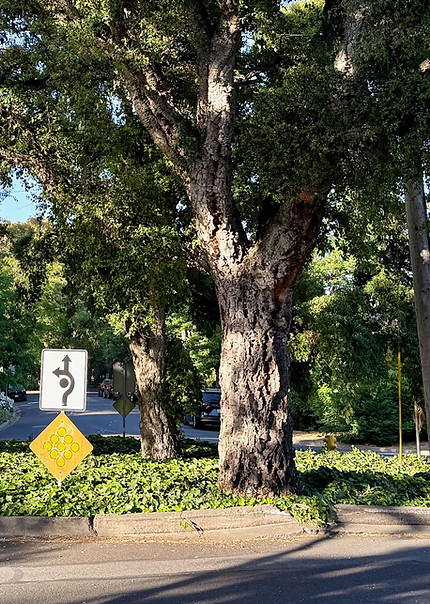Tree Tales from San Mateo Park
Fun facts and stories about trees in The Park.
Dawn Redwoods
Dawn redwoods are rare because they lose their needles in winter—the only redwood that does! They’re called “living fossils” because they were first known only from fossils before being found alive.
You can find several in The Park:
-
A young, fluffy one at W. Poplar & Costa Rica
-
A larger one with striking bark at W. Poplar & Hillcrest
-
This large one at right, in backyard of 105 W Bellevue Ave
The Discovery
In 1941, Japanese paleobotanist Shigeru Miki identified a new fossil species: Metasequoia. Around the same time in remote western China, villagers discovered huge, ancient trees—one was over 100 feet tall and 450 years old. Scientists realized they matched Miki’s fossil: they were alive!
Redwoods in The Park
Many U.S. dawn redwoods grew from seeds from those Chinese trees—maybe ours did too! When in leaf, they look like small coast redwoods but have:
-
Bright apple-green, soft needles
-
Small cones
-
Needles in pairs on short branches
-
Coppery fall color before shedding
Tip: Visit throughout the year to spot seasonal changes and compare them with nearby coast redwoods.
A Happy Ending
In 1980, China protected the original trees. Here in San Mateo Park, we’re doing our part to preserve them too.

Cork Oaks
As you walk around The Park enjoying the magnificent trees that were planted here at the beginning of the last century, notice the Quercus suber, a member of the Oak family. Called "Cork Oaks", they are native to the semi-dry Mediterranean, and also grow here. Their thick, soft bark is real cork! Fun facts:
-
Cork harvesting: Cork oaks must grow for about 25 years before their bark can be harvested for the first time. After that, cork is sustainably stripped every 9–12 years without harming the tree, which can live for over 200 years and be harvested many times throughout its life.
-
A tree can produce over 1,000 lbs of cork per harvest
-
Please don’t touch—damage could kill the tree!
U.S. History
Thomas Jefferson sent the first cork oak acorns to the United States from France in 1787, but it was not until 1858 that interest in these majestic trees took root. In the following years, many acorns were imported from Spain and distributed throughout the South and in California. About 600 trees were planted at Chico by the University of California in 1904.

Tree Features
-
Slow-growing and long-lived (some live 500+ years)
-
Grow 60–100 feet tall with wide, rounded canopies
-
Evergreen leaves: shiny green on top, gray below
Where to Spot Them
Look for cork oaks on these island blocks:
-
W. Bellevue (first block)
-
W. Bellevue & Hurlingham (shown at right)
-
Warren between Hurlingham & Crescent
-
W. Poplar between Hurlingham & Crescent (newest planting)
This last location was replanted after cold weather killed previous silk oaks.
Got Tree Tales?
If you know fun stories, facts, or legends about Park trees, email them to board@sanmateopark.org —we’d love to share them!
